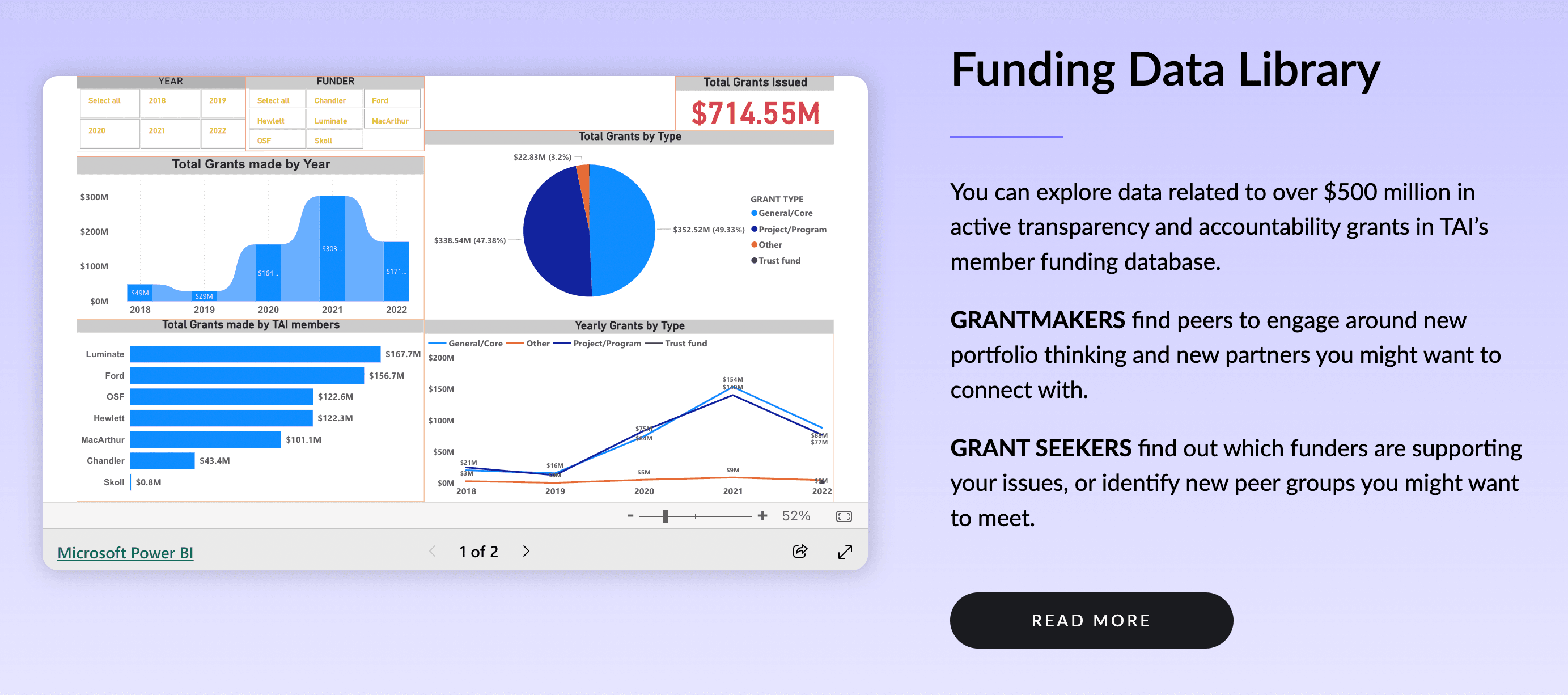Members of the Trust, Accountability and Inclusion Collaborative (TAI) annually channel their support to organizations across the globe working to counter TPA-related challenges. Yet, there is not a centralized platform to weave together and showcase the intricate threads of this type of funding.
In 2018, TAI took up the challenge to shed light on the philanthropic landscape by diligently compiling and publishing the transparency, participation, and accountability (TPA) grants database of its members. Today, we present to you a dynamic Power BI report, a significant leap forward from our previous work.
This visual report paints a vivid picture of the trends shaping the TPA funding landscape by integrating detailed analyses, interactive graphs, charts, and tables. Whether you're a funder, grantee, civil society organization, non-governmental organization, journalist, or researcher, we're thrilled to share snippets that will inspire you to explore further on your own.
Before we plunge into our report details, a gentle reminder – the data presented here doesn't encompass the entirety of TPA-related funding from our members. It's a snapshot, capturing the essence of programs engaged most directly with TAI, programs that are integral within the tapestry of our member funders. We'll delve deeper into the nuances and limitations shortly, but for now, let the exploration begin!
What can you find?:
On page one we can find 4 visuals: A ribbon chart with a comprehensive view of total funding trends from 2018 to 2022, allowing us to observe fluctuations in Transparency, Participation, and Accountability (TPA) funding by members. This visual is a valuable starting point for delving into the dynamic priorities that have shaped our member organizations over the years.
In the pie chart, we present the distribution of total funding by grant type. General/Core funding takes the lead with 49.33%, closely followed by project/program support funding at 43.38%. Trust funds and other grant types collectively make up the remaining 7.29%.
The bar chart visually depicts each member's contribution to the total funding during the period. Notably, Luminate, Ford, OSF, Hewlett, MacArthur, Chandler, and Skoll emerge as key contributors, listed in order of importance. It's worth mentioning that Packard, having joined in November 2023, is not included in this particular visual.
The first page ends with a line chart providing a year-on-year comparison of total funding based on grant types, offering insights into the evolving financial support patterns.
Page 2 starts with a bar chart presenting instances of co-granting by members throughout the period. Notably, there were 44 occasions where two or more members jointly funded the same grantee within a grantmaking year. The highest occurrences were in 2021 (27 instances), followed by 2020 (10 instances), 2022 (4 instances), and 2018 and 2019 with 2 and 1 instances respectively. For a detailed breakdown, refer to visual six (bar chart).
The bar chart delves deeper into the co-granting instances, providing a nuanced breakdown of each year's collaborative funding efforts among members.
Concluding our visuals, a final bar chart showcasing the number of grantees supported by each member over the period. Ford stands out, supporting 370 grantees, followed by Luminate with 351, OSF with 269, MacArthur with 199, Hewlett with 167, Chandler with 36, and Skoll with 4 grantees. These numbers offer a glimpse into the impactful contributions of each member toward advancing transparency and accountability initiatives.
Limitations:
This report may not encompass the exact details contained in the individual databases of each member. It relies solely on the datasets submitted to our Monitoring, Evaluation, and Learning (MEL) team for analysis.
The report lacks location-disaggregated data, making it challenging to identify the specific beneficiaries of the funding at the last mile. This is due to incomplete location data in the received datasets. However, our MEL team is actively working on filling these gaps to ensure comprehensive reporting in the future.
Our members did not include USAID, despite their longstanding status as an observer and effective collaboration with us. In the next report, we intend to broaden the scope by incorporating USAID data, as well as the data from the newest member, Packard Foundation.
Conclusions:
Our comprehensive dashboard has been developed to serve as a one-stop platform for TAI members to access the funding database of others, while also providing stakeholders with valuable information about TPA funding. But, dear reader, the adventure doesn't conclude here – it's an open invitation to dive deeper into the data ocean. For the data geeks among us, the database is your playground. Download it, wield your analytical magic, and sculpt your insights based on your unique interests. The narrative of transparency, participation, and accountability eagerly awaits your contribution.
Happy analyzing!
Contextualizing the Terms and Concepts Used:
1. Grants: The monetary support, in United States dollars, provided directly or indirectly to projects or programs.
2. Grantee: An organization or entity that receives grants directly or indirectly from TAI members for implementation or regranting purposes.
3. Members: Grantmaking entities that constitute the TAI collaborative, including the Hewlett Foundation, Luminate, Ford Foundation, MacArthur Foundation, Chandler, Skoll Foundation, Open Society Foundation (OSF), and Packard Foundation.
4. Transparency, Participation, and Accountability (TPA) topics: These encompass priority areas such as Just Transitions, Healthy Information Ecosystems, good governance, climate justice, and illicit financial flows, among others.
5. Types of grants: In this report, members' grants are classified based on their purpose, including General/Core support, Project/Program support, Trust Fund, and Others (those that do not fall under the listed categories).
6. Co-grant: Refers to grants issued by at least two TAI members to a single grantee within the same grantmaking window.
